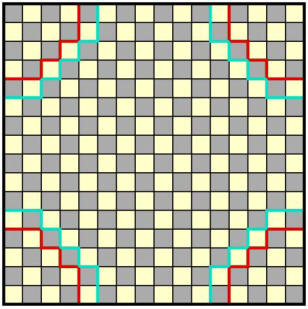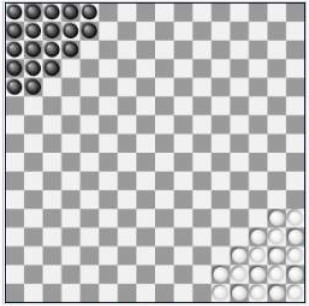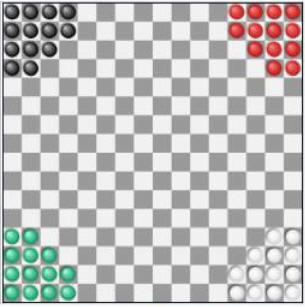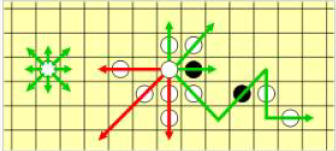
Fig 1. The board
Halma Dice Game
Jeux
Setup
• The board consists of a grid of 16×16 squares (as in
Figure 1).
• Each player's camp consists of a cluster of adjacent squares
in one corner of the board. These camps are delineated on the board (as in
Figure 2).
• For two-player games, each player's camp is a cluster of 19
squares. The camps are in opposite corners.
• For four-player games, each
player's camp is a cluster of 13 squares. Each of the four corners of the board
is a camp.
• Each player has a set of pieces in a distinct color, of the
same number as squares in each camp.
The game starts with each player's
camp filled by pieces of their own color.

Fig 1. The board
| Setup for two players | Setup for four players (When played as a team the teammate sat at the opposite corner) |
 |
 |
The Rules
• Players randomly determine who will move first.
• Pieces can move in eight possible directions (orthogonally and diagonally).
• Each player's turn consists of moving a single piece of one's own color in one of the following plays (as in Figure 3):
• One move to an empty square:
• Place the piece in an empty adjacent square.
• This move ends the play.
• One or more jumps over adjacent pieces:
• An adjacent piece of any color can be jumped if there is an adjacent empty square on the directly opposite side of that piece.
• Place the piece in the empty square on the opposite side of the jumped piece.
• The piece that was jumped over is unaffected and remains on the board.
• After any jump, one may make further jumps using the same piece, or end the play.
• Once a piece has reached the opposing camp, a play cannot result in that piece leaving the camp.
• If the current play results in having every square of the opposing camp occupied by one's own pieces, the acting player wins. Otherwise, play proceeds clockwise around the board.

Movement valid in green and invalid in red.
TWO HANDED GAME TO START
Each player places his nineteen pieces within his starting: "Yard" and one player is chosen by the throw of a coin or otherwise to make the first move.
TO PLAY
The game of HALMA may be divided into three different parts.
First, there is the moving and jumping of pieces by each player to get them out of his own starting "Yard" on to the central playing apace on thy board.
Naturally, in doing this, players' pieces will soon contact each other and this opens up the second part of the game which is a struggle by each player to get his pieces through, or past, those of his opponent.
The third stage then commences in which a player attempts to move all his pieces into his opponent's ''Yard" and thus Win the game.
All moves and jumps must follow along the lines on the board. Pieces which are jumped are not removed, but remain in place on the board.
The movement of one piece constitutes a turn.
This piece may be moved only one space but, by jumping one piece at a time, it may be advanced in a series of jumps any distance across the board, provided always that it jumps another piece on a space next to ii and that each single jump is over one piece only and is in a straight line.
Jumps may be made over a player's own pieces or those of an opponent in any order, in any direction along a line on the board.
It will be found, by properly placing pieces (by moving or by jumping) that a so-called ladder may be made across the board which will enable a piece to make a series of -jumps for a considerable distance.
NOTE:
Such a ladder may be of assistance to a player's opponents as well as to the player himself and care should be used to block off such a ladder from an opponent's use.
No player may leave his pieces in his own starting "Yard" for the purpose of blocking out another player and preventing: him from winning the game.
A player must move or jump each time it is his turn to do so but he is not compelled to jump at any time he does not wish to do so, provided he is able to move one of his pieces.
TO WIN
The winner of the game is the player who first gets all nineteen of his pieces into his opponent's "Yard" directly across the board from his own Starting "Yard."
THREE-HANDED GAME
HALMA was not designed for a three-handed game but a fairly satisfactory game may be played if two players use nineteen black and yellow pieces and the large yards and the player sitting between them uses thirteen pieces and a smaller yard.
The play is similar to that of the two- handed game. Black and yellow attempt to get all their nineteen pieces in each other's yard to win and the third player tries to get his pieces in the unoccupied yard directly across the board from him.
FOUR-HANDED GAME
When four play, only thirteen pieces are used toy each individual player and the six extra spaces, forming the two larger "Yards," are used simply as playing spaces on the board.
In the four-handed game of HALMA, each person may play individually or players sitting opposite each other may combine as partners to form two sides.
When the individual game is played the play is the same as in the two-handed game and the player who first gets all his pieces in the yard across the board from his starting position Wins.
In the partnership game, partners who sit opposite one another assist each other in every way they can in an attempt to get their pieces across the board, forming a ladder, and making such other plays as will assist their partners in getting their pieces across more rapidly.
A partnership game may be won in either of two ways, one of which must he decided upon before the game starts
1. The first player to get all of his pieces in the yard directly across from his starting point Wins for his side.
2. Both partners must get all their pieces home to Win. In this method players whose pieces are home may utilize their turn to assist their partner in moving his pieces.
NOTES
JUMPING
A move may or may not advance a piece to a space of a different color from that on which it stood, hut a jump, single or multiple, cannot possibly take the man to a space different in color from that on which it started.
This test will detect the error when a player has carelessly taken a false jump, which is not in a straight line.
It is usually best to get all pieces moved out of your Starting "Yard" early in the game, ('are should be taken not to allow lagging pieces to toe separated by too great an interval from the main body, nor to allow the advance pieces to block the way.
It will be found advisable to move the first few pieces into the "Yard" in such a way that the following pieces may jump in more rapidly.
A few moves with the first men who enter will often save double the number of moves with the last men to come in.
